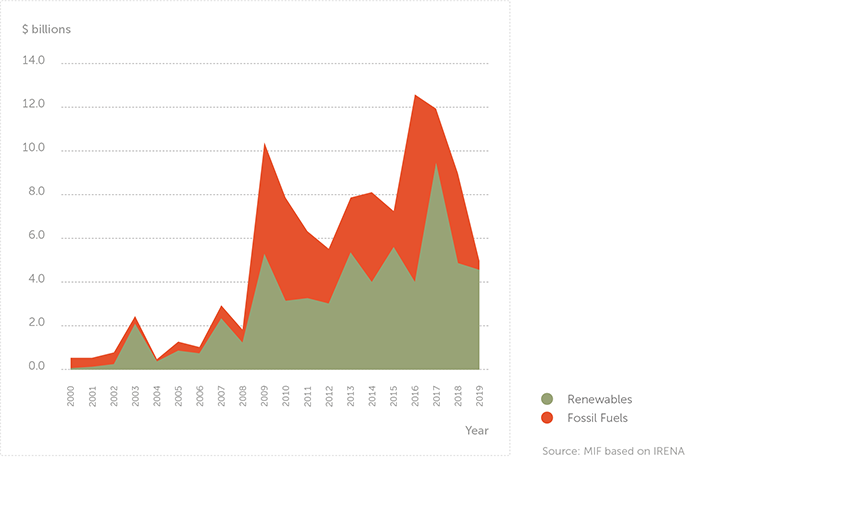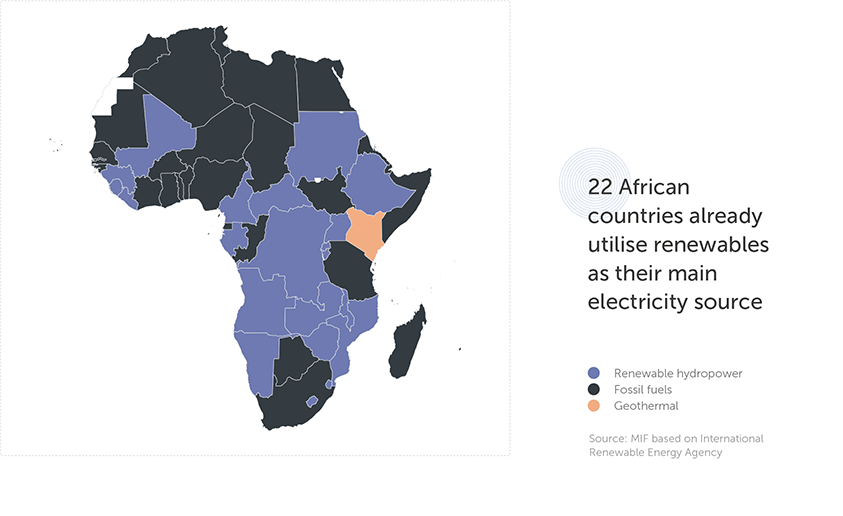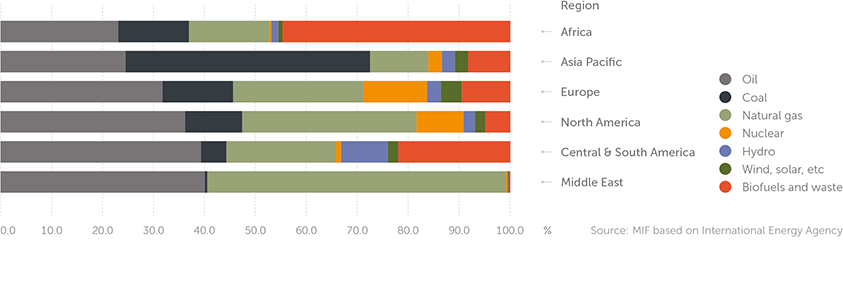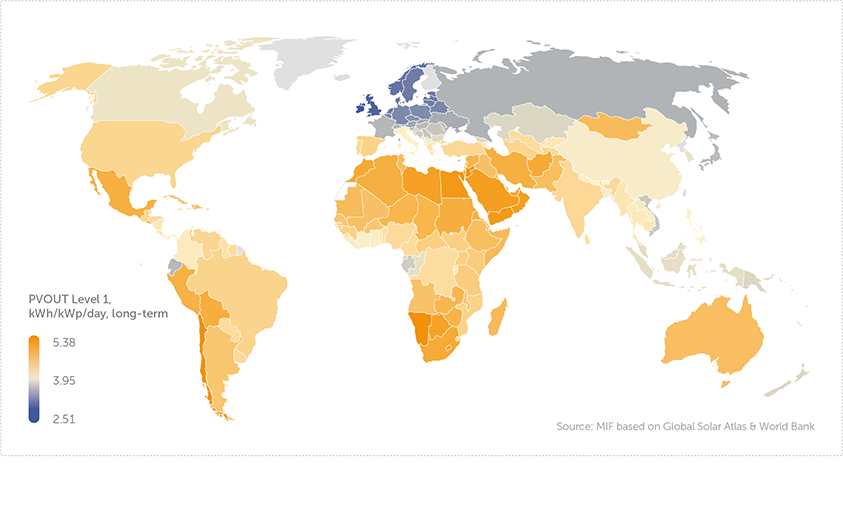

Spotlight: Renewable Energy in Africa
By Ben Chandler, Senior Researcher
Africa is the continent with the lowest rates of energy access globally, so it faces the unique challenge of needing to develop its energy infrastructure amid a global climate crisis it did little to cause. Addressing this energy deficit requires the mobilisation of the continent’s vast renewable resources, as well as natural gas, the least polluting fossil fuel.
African governments have made significant progress in developing renewable electricity in recent years, and fossil fuels account for a smaller share of the energy mix than in any other region. However, Africa’s energy deficit remains large and significant renewable potential remains untapped.
African governments have scaled up investment in renewables
The potential of renewable electricity in Africa is undoubtedly vast, and African governments have already recognised the role renewables can play in addressing the continent’s energy deficit.
African governments: public investment in electricity generation (2000-2019)
Research Spotlight series
A series exploring data and key findings from the Foundation's Research publications.

Between 2010 and 2019, African governments more than tripled public investment in renewable electricity, up to $47.0 billion from $13.4 billion the previous decade.
22 African countries already use renewables as their primary source of electricity
As it stands, zero-carbon electric grids remain very rare. However, 22 African countries use renewables as their primary source of electricity generation.
On average, African countries use renewables for 40.5% of their electricity generation.
This is higher than…
- the global average (34.1%)
- the EU average (39.1%)
- the UK (37.9%), Japan (18.6%) and the US (17.9%).
African countries: primary source of electricity (2019)

Some African countries are even leading the way globally in these figures.
- In Kenya, geothermal energy accounts for almost half (46.0%) of electricity generation, more than any other country in the world.
- In Namibia, almost one fifth of electricity (19.1%) is generated through solar, the fourth highest share globally.
- 21 of the 52 countries using hydropower as the primary source of electricity are African.
Africa uses the least fossil fuels in overall energy supply
Energy Supply
The energy supply accounts for all fuels and technologies used for generating electricity, powering industry, transport, and infrastructure, as well as domestic cooking and heating among other uses.
Electricity
Electricity only accounts for around one fifth of all energy consumed globally. It does not account for other forms of energy such as petrol and diesel fuels frequently used in transport, or biomass and charcoal which are frequently used domestically for cooking and heating. Electricity only covers 1.2% of all energy used for transport, 24.9% of all energy used for residential purposes, and 28.5% of all energy used for industry.
Fossil fuels still account for over half of the energy supply in Africa, though this is the least of any world region. By comparison, fossil fuels account for:
- Almost the whole energy supply in the Middle East (99.2%).
- Over three-quarters of the energy supply in Asia Pacific (84.0%) and North America (81.7%).
- Roughly two- thirds of the energy supply in Europe (71.3%) and Central and South America (65.8%).
World regions: total energy supply by source (2019)

Access to energy remains key challenge
| Country | Renewables as a % of electricity generation (2019) | Primary source of electricity (2019) | Population, millions (2021) | Access to electricity % (2020) | Access to clean cooking fuels % (2020) | Fossil fuels as % of exports (2021) | Primary source of energy (2019) |
| Angola | 71.9 | Renewable Hydropower | 34.5 | 46.9 | 50.2 | 93.7 | Oil |
| Burundi | 76.2 | Renewable Hydropower | 12.6 | 11.7 | 0.2 | 1.3 | No data |
| Cameroon | 79.5 | Renewable Hydropower | 27.2 | 64.7 | 21.9 | 49.7 | Biofuels and waste |
| Central African Republic | 96.3 | Renewable Hydropower | 5.5 | 15.5 | 0.8 | 0.1 | No data |
| DR Congo | 98.9 | Renewable Hydropower | 95.9 | 19.1 | 3.7 | 3.4 | Biofuels and waste |
| Eswatini | 99.8 | Renewable Hydropower | 1.2 | 79.7 | 55.4 | 1.9 | No data |
| Ethiopia | 100.0 | Renewable Hydropower | 120.3 | 51.1 | 7.8 | 0.0 | Biofuels and waste |
| Gabon | 54.0 | Renewable Hydropower | 2.3 | 91.6 | 88.1 | 55.8 | Biofuels and waste |
| Guinea | 63.4 | Renewable Hydropower | 13.5 | 44.7 | 1.9 | 3.9 | No data |
| Kenya | 79.7 | Geothermal | 53.0 | 71.4 | 19.5 | 4.0 | Biofuels and waste |
| Lesotho | 99.9 | Renewable Hydropower | 2.3 | 47.4 | 40.1 | 0.0 | No data |
| Liberia | 56.6 | Renewable Hydropower | 5.2 | 27.5 | 0.4 | 0.2 | No data |
| Malawi | 77.3 | Renewable Hydropower | 19.9 | 14.9 | 1 | 0.0 | No data |
| Mali | 60.4 | Renewable Hydropower | 21.9 | 50.6 | 0.9 | 0.3 | No data |
| Mozambique | 95.4 | Renewable Hydropower | 32.1 | 30.6 | 5.1 | 30.9 | Biofuels and waste |
| Namibia | 91.0 | Renewable Hydropower | 2.5 | 56.3 | 46.8 | 1.3 | Oil |
| Rwanda | 54.1 | Renewable Hydropower | 13.5 | 46.6 | 2.4 | 3.4 | No data |
| Sierra Leone | 75.6 | Renewable Hydropower | 8.4 | 26.2 | 0.8 | 0.6 | No data |
| Sudan | 61.4 | Renewable Hydropower | 45.7 | 55.4 | 54.7 | 7.6 | Biofuels and waste |
| Uganda | 97.7 | Renewable Hydropower | 45.9 | 42.1 | 0.5 | 4.6 | No data |
| Zambia | 82.8 | Renewable Hydropower | 19.5 | 44.5 | 10.4 | 0.2 | Biofuels and waste |
| Zimbabwe | 60.7 | Renewable Hydropower | 16.0 | 52.7 | 30.4 | 0.3 | Biofuels and waste |
Table 1: African countries primarily using renewable electricity
Access to energy, rather than the transition away from fossil fuels remains the key challenge for African countries:
- In 16 of the 22 countries that primarily use renewable electricity, more than half the population still lack access to electricity.
- Overall, more than 600 million in Africa still lack access to electricity and over 930 million lack access to clean cooking fuels.
- Africa accounts for 17% of world’s population but only 5.9% of world’s energy supply.
Much of Africa’s renewable potential remains untapped
In the short to medium-term, lower emission fossil fuels such as natural gas will still have a role to play in addressing Africa’s energy deficit.
However, substantial untapped renewable potential remains that can help increase electricity access. Realising such potential will require climate pledges from wealthier countries to be realised and for an increase in the meagre 5% of climate finance sub-Saharan Africa received of the total distributed to countries outside of the OECD.
Solar
Africa has 40% of world’s potential but just above 1% of installed capacity
- Five of the ten countries at the global level with the potential to generate the most energy per solar panel are in Africa: Namibia (1st), Egypt (4th), Lesotho (8th), Libya (9th), Botswana (10th).
- Launched by the AfDB in 2021, the Desert to Power Initiative should increase existing capacity of the eleven countries in the Sahel region by almost 40% and bring electricity access to 90 million people for the first time by 2030.
World countries: average practical potential in photovoltaic solar output per installed unit (2020)

Wind
Wind power is still to get off the ground in Africa, with the continent’s wind potential largely untapped.
- Full mobilisation of technical wind potential would increase electricity capacity more than 30-fold in Chad, Mauritania, Niger and Mali.
- Seychelles is among the ten countries across the globe with the highest per capita potential for offshore wind globally.
Hydro
Hydropower remains the continent’s primary renewable for electricity generation, accounting for 70% of the renewable electricity share. However, the full potential of hydropower on the continent is nowhere near being realised.
- Grand Inga, in the DR Congo, could produce up to 40,000 MW of electricity, twice the power generation capacity of the world’s current largest dam, China’s Three Gorges, and equivalent to over one third of the total electricity produced in Africa.
Geothermal
21 African countries have known resources, that are mainly unexploited.
- In Ethiopia and Kenya, geothermal could more than triple current electricity capacity.
- Ethiopia and Kenya are among the 10 countries at global level with the largest public investment in geothermal electricity.
Green hydrogen
Green hydrogen has been gaining traction in recent years due to its potential in the automotive, industrial and construction sectors. While not a feasible short-term solution to Africa’s pressing energy needs, the continent has long-term advantages that place Africa at the forefront of a green hydrogen future.
- In May 2022, six African countries – Egypt, Kenya, Mauritania, Morocco, Namibia, and South Africa – launched the African Green Hydrogen Alliance. The alliance plans to foster collaboration between its founding members to advance green hydrogen development in their respective countries.
- Namibia aims to start producing 300,000 tonnes of green hydrogen per year by 2026, replacing South African coal in the country's energy mix.
- Egypt is planning three green hydrogen projects with a combined capacity of 300 megawatts.